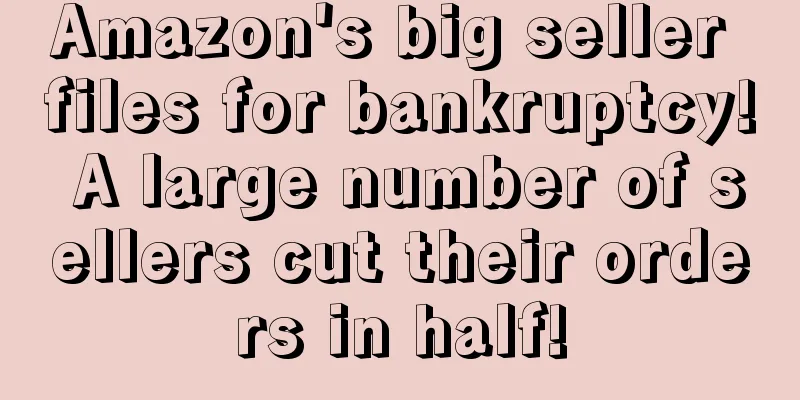|
Hello everyone, our company has its own factory, 10% of the products are self-produced, and the inventory management and stocking of this part will not be discussed. 90% are purchased from outside, and there are many SKUs, more than 100, which are not distributed or carefully stocked.
Since the beginning of this year, the company's management has gradually discovered a problem. The monthly inventory volume seems to be becoming more and more uncontrollable. Here I will first describe a specific process of our company's inventory preparation:
1. Operations need to provide inventory quantities for the next few months at the end of each month. Of course, the inventory quantity for the next month cannot be modified because it is already at sea.
For example, at the beginning of June, the operation department needs to give the sales volume for September, and then we place an order in June and it takes 30 days + 45-60 days for shipping, so the goods can arrive in September.
2. Our products can only be shipped by ordinary ships, and it takes us about 45 days to 60 days to receive and put them on the shelves.
The purchasing department places orders based on this forecast. For example, if it is May now, we will generally place orders for the quantity that will be delivered to FBA in July.
However, management's concerns are as follows:
How to ensure that the quantity forecasted by each operator or operation team leader is not particularly biased, such as blindly preparing too much? Or cautiously preparing too little? (The management understands that the shipping cycle is long and the forecast of the quantity in the next few months is biased)
In fact, every operation or team leader can get the company's historical data and various plug-ins. We have also conducted relevant training. The management feels that the operation is responsible for making plans, which seems to mean that they have to do as much as they say. It seems that they have lost control of the process. One vice president said: She said she thought about it, but who knows if it is comprehensive? The outcome will not be known until two months later. Who is responsible for the result?
In response to these, our company has actually implemented various indicator controls. For example, we also conduct target sales management and 90-day FBA inventory turnover assessment every year. However, I personally feel that these things are not effectively implemented in process management. It is still result management. If there is a problem, our middle-level management will have to take the blame, hahahaha, so I came here to ask for advice.
After reading the article on Zhiwubuyan, I actually understand the logic, such as weighted calculation/ranking sales forecast/activity sales forecast, etc. However, this is still done by the operations department, and I feel that it is still not thorough. Is there any corresponding process management method for middle-level managers?
I have said a lot and it feels very long-winded, but I hope that some knowledgeable people can provide some help. Thank you all. "Wonderful Reply"
Vae - advertising, refined operations The principle of operation is to ensure that there is no shortage of goods. After all, those who have done operations know that out-of-stock situations have a great impact on the recovery of link promotions. At the company's management level, the most ideal sales rate is used to ensure that inventory is not piled up.
Replenishment is a subjective judgment based on objective data. The longer the stocking cycle, the greater the risk of fluctuations. To reduce subjectivity in stocking, standards must be set according to segmented criteria. Determine sales volume --- determine the stocking cycle --- place an order for stocking;
The logistics cycle should be determined by combining logistics time + shelf time. We need to calculate it in a sufficient way. We use Haika, and now it is calculated based on 45 days. Because the production cycle and logistics cycle are relatively stable, the main difficulty in controlling is the sales volume.
The sales volume can be weighted averaged over the last 7 days, 15 days, and 30 days, with a ratio of 2:3:5, to determine the average daily sales volume. These standards are determined after discussion, and once the standards are determined, the subjectivity will be reduced a lot.
Many of our products are large and have a long production cycle. They can only be shipped by sea. Our stocking cycle is about 70-90 days. Here are some of our experiences and methods of stocking:
1. Our operations department proposes stocking requirements, which are then reviewed and approved by the supervisor (who has operations experience). This is a preliminary review of the rationality of the stocking.
2. Prepare 10-20 days of safety stock; after determining according to the above standards, because the market is volatile, the promotion of links, the influence of competing products, and the impact of big promotions will affect the subsequent sales trend. We will also add a safety stock to avoid sales gaps caused by emergencies.
3. You have your own factory, so I am not sure whether your stocking time is stable. We usually have a 3-6 month stocking plan for our products. For example, one container is shipped on May 1, one container is shipped on June 1, and one container is shipped on July 1. This advance planning also reduces the impact of production cycle fluctuations.
4. Ship in small quantities and multiple batches. If the growth difference between full container and bulk is not big, you can adopt this method. The biggest advantage of this method is flexibility, and you can adjust the strategy in time. Suppose you need to prepare a cabinet and ship it in three batches. For example, ship one-third on May 1, one-third on May 11, and the remaining one-third on May 21. Suppose you find that sales have dropped a lot on May 5, then you can delay the shipment of the replenishment after May 11.
5. Every company wants the highest inventory turnover, and it is best to sell out as soon as it arrives at the warehouse, and there is no shortage of stock. However, this is not displayed. Here, it is recommended that you distinguish between key products and other products. Key products are safety stocks, and the stocking quantity can actually be larger (this is not subjective, but to set the corresponding safety stock, and the number of days corresponding to the safety stock of key products should be set higher).
The sales volume of key products is relatively stable with little fluctuation. At this time, it is relatively low-risk to be a little bold in stocking up, so as to avoid irreversible damage to the link caused by out-of-stock.
Taking a step back, assuming that the sales of key products have really dropped, firstly, the operation can take measures to stabilize the sales, and secondly, there is already a sales basis. Previously, 20 orders were placed a day, and now 15 orders are placed a day. The inventory is moving a little slower, but it is not unsalable, so it is still acceptable overall.
Anonymous user
First of all, I really appreciate the original poster bringing up this topic, which is very worth discussing. I believe that many big sellers of large products have also encountered this problem.
Below I would like to offer some of my own views based on my personal work experience for your reference.
A big premise is that the forecast cannot be accurate because there are too many influencing factors, including the market environment (i.e. category traffic), competing products (price, whether there are promotions, etc.), the turnover of one's own products and inventory status, etc. In addition, the poor timeliness of sea transportation increases the difficulty of forecasting.
In addition, Amazon does not release big data and trends for some categories, so it is very difficult to use big data or AI to make predictions. We have tried various prediction models, including training AI to understand the approximate popularity and traffic of the category in which the product belongs (based on the current 100 products in the category), but the results have not been good.
So, when operations are predicting, it is actually a game process, there will be radical and conservative, and the prediction will definitely be based on the most recent sales volume as a direct index. The result of the game is redundancy and out of stock. In rare cases, there will be no redundancy and no out of stock.
Gambling is risky. In addition, sometimes leaders’ micro-operations (such as adjusting prices, or the goals themselves are very aggressive, which means aggressive stocking) make this process itself less controllable. It is indeed mostly result-oriented, so it is inappropriate to let operations take all the responsibility.
Here are some ways I think we can manage it:
1. Monitor the logistics cycle of products that have been shipped and in transit. If the cycle is too long/too short, the operation department can be prompted to intervene in advance to control sales.
2. For long-term hot-selling items, if the forecast is conservative, it is necessary to prepare spot stocks abroad or domestically, at least 2-3 weeks of sales volume, so that they can be shipped in time when they are selling out.
3. Real-time monitoring of sales volume - if the sales volume drops by 20% or more in the past 2-3 weeks, the shipment can be reduced or suspended, and the quantity of orders already placed can be appropriately reduced or the next batch of orders can be postponed through negotiation with the supplier;
If sales volume increases by more than 20% month-on-month, spot inventory will be automatically transferred from abroad/domestic, and a faster logistics method can be selected if necessary. The above requires operations to follow up and adjust forecasts, and logistics and supply chain cooperation to reduce supply instability caused by sales fluctuations.
4. Dynamic management: A product has a certain life cycle, and not all products can last forever. It is necessary to carefully grasp the product life cycle (new product, growing product, mature product) and dynamically determine the replenishment mode (large batch replenishment, small batch replenishment, multiple replenishment, etc.).
Generally speaking, new products and long-tail products have a high probability of redundancy, and I believe that most of the redundancy comes from these products. Therefore, for these products, dynamically confirm whether to restock them. The sales loss caused by out-of-stock is not large. Those that should be eliminated should be eliminated, leaving supply resources for hot-selling styles. The team needs to be flexible and communicate at any time, and does not necessarily have to wait for feedback from operations to drive sales.
5. If conditions permit, automatically pull the overall popularity and traffic of the top 100 in the market (category) where the product is located for monitoring, monitor whether major competitors have significantly reduced prices, and minimize monitoring of external uncontrollable factors to stabilize expectations.
6. When making decisions, management needs to refer to these factors that affect sales, the market environment, etc., to determine the development strategy and goals that are suitable for their own company and product lines - the goals need to be achievable and based on current and future expectations.
Don't get carried away and blindly set unrealistic strategies and goals, which will not benefit the company's development. Try to reduce micromanagement in the operation process, and communicate more with colleagues in various departments when adjustments are needed. This requires the leader to have a certain strategic vision and pattern, which not all managers can do.
This is just my personal opinion. If you find any shortcomings, please point them out and discuss. I wish you great sales!
Anonymous user
Amazon is a company that has grown in size. Although it has a full staff of managers, the management logic of stocking inventory is still unclear.
This problem is not complicated and can be easily solved. We just need to understand the logic and purpose of stocking.
Which people or factors determine the amount of inventory to be prepared?
A. Operations or Operations Team Leader B. Logistics Manager (in charge of shipping) C. Purchasing D. Finance E. Boss
F. Companies with high staff turnover also need human resources to judge whether operations are reliable.
Without considering labor efficiency, it is possible for only one person to decide the inventory quantity. However, when the company has grown in scale, with so many people in different positions and many things that need to be coordinated, the labor efficiency factor must be considered.
Because no matter how capable a person is, he or she cannot achieve seamless integration, let alone be a jack of all trades and work in multiple positions part-time. Therefore, the efficiency of these five departments can determine and affect the amount of inventory. No matter what the inventory logic is, the final actual result will be affected by the processing capabilities of these five departments.
So how can we prepare stocks reasonably? First, we need to consider the purpose of reasonable stocking. There should be only one purpose: to maximize the company's interests and minimize risks.
This goal can be measured by the capital utilization efficiency and inventory turnover rate indicators. These two indicators are coordinated by the above five departments. Therefore, it is quite complicated to make a good stocking plan. It is determined by multiple departments and multiple factors.
Before giving specific methods to improve stocking, there are a few issues that need to be clarified.
1. What kind of product can still be popular in the next five months?
Because we are not clear about the products, it is really risky to prepare 5 months of goods. According to the existing production and logistics schedule, preparing 5 months of goods at a time is a disadvantage in this regard. After all, it is a market economy, and market factors change very quickly. If we still rigidly stick to the previous planned economy, there will definitely be problems.
I don't doubt your company's ability, but I'm really behind in this aspect. No matter what product, from placing an order to production to logistics delivery to foreign countries, 3 months is the longest period. The fastest seller can get it done in a month by sea freight. In comparison, 5 months is not efficient. Can you compete? Unless the product is really sold exclusively, there is no worry about sales.
No matter what logic and stocking model, 5 months is too long, and the data here is difficult to be accurate. If the operation is asked to give data, it is nothing but fabrication. Can the operation decide when the procurement will take the goods back, when the logistics will label and pack the goods, and send them away? The main thing is that the operation cannot control the shipping schedule, not to mention when the finance department will pay, and the boss will make new models on a whim. These are all factors to be considered. Even if we don’t consider labor efficiency, what will the market look like after 5 months, what will the links look like, can the operation predict and operate?
The only thing operations can do is to find ways to control sales and convert existing inventory into cash, rather than planning for 5 months of stock, which is somewhat inconsistent with the job responsibilities of operations.
2. Our products can only be shipped by ordinary ship
This is because the product is large and heavy and can only be shipped by ordinary ship, or it is because ordinary ship is used to save costs. This mode of transportation has a great impact on the stocking plan.
It is a bit outrageous that products with 100+ SKUs can only be shipped by ordinary shipping. Either there is a problem with the company's product selection. According to the requirements of cross-border e-commerce, the turnover rate must be very fast. Even companies with good cash flow will have some fast-moving consumer goods. Your company can only ship by ordinary shipping and does not even consider time-limited delivery. Are you too confident in your products, or your cash flow is so good that you don't need to consider the turnover rate?
Based on the above two factors, any kind of indicator control will be ineffective, because the basic indicators are fixed and there is no room for optimization. If you want to optimize, you have to change the basic indicators.
I am not sure why your company chose this model. If you want a reasonable inventory management method, please give a reasonable explanation in these two aspects, and be as detailed and specific as possible. Only in this way can we optimize the product supply chain and logistics supply chain, and then come up with the best inventory management plan.
If you can't give it, consider changing these two indicators. It would be best if they can be changed. There are many management methods and they are very flexible, but you still need to understand the specific situation first.
Lee Shanchang - Lifelong Learning Similar to our situation, I guess the poster is also engaged in large European products, and may be a competitor, but in the spirit of communication and sharing, he is willing to share some experience. We have also encountered the situation of blindly preparing too much and cautiously preparing too little.
First of all, our core goal is to prepare inventory accurately. Ideally, when the new cabinets arrive, the old inventory is sold out. For large products, the monthly storage fee is not a small fee, and the monthly storage fee is calculated based on the products in the warehouse every day, so the goal of inventory management is to ensure that the inventory quantity in the warehouse is the minimum under the premise of not stopping the supply.
To put it bluntly, a small amount of inventory backlog is allowed, but out-of-stock conditions are absolutely not allowed (from actual testing, for a top link with stable sales, the loss from being out of stock for one week is 5 times that of a month of backlog). In order to achieve this goal, we have prepared from multiple aspects.
Preparation and shipment stage:
Preliminary preparation: Operations are required to compile statistics on the links, core competitors, and market abnormal performance every week.
For example, "Due to inventory backlog, a large discount will be offered this week", "Competitor A is out of stock", "The overall market has become weaker, the ranking of small categories remains unchanged, and the ranking of large categories has declined significantly." The reason why operations are required to collect statistics every week is that we have found that when referring to sales data from previous years, we will encounter inaccurate data. The reasons that caused sales changes in the same period of previous years may not exist this year. The most serious example is that from April to June 2022, the demand in Europe fell sharply due to the Russian-Ukrainian war.
For example, if a product was out of stock for a week in June last year, and the monthly sales volume was 2,500, in June this year, 3,500 units should be prepared to ensure that the product is not out of stock. For another example, for a product in the promotion period, the data for the first year is meaningless. You need to combine the current ranking with comparable competitive products to estimate the data.
Summarize: It is necessary to understand the interference factors of historical data, combine them with the current situation, determine whether the interference factors continue to exist, and obtain revised reference historical data.
Stable sales products. For stable products with a sales cycle of more than one year, combined with 1. Corrected historical data 2. Changes in market supply and demand 3. Growth expectations Market supply and demand changes, that is, whether core competitive products continue to rise, whether there are threatening new products launched in the market, and whether market demand has a significant decline or increase; growth expectations, that is, whether there are plans to continue promoting this product.
New products in the promotion period. New products with a sales cycle of less than one year need to be combined with 1. Whether the product has been verified and there are no risks due to product mismatch with demand, product quality and function risks. 2. Benchmark core competitive products and determine ranking and sales volume according to promotion goals in stages 3. Controllable promotion methods to ensure that the product is always in stock
For new products with a sales cycle of 6 months, we mainly verify the product and market demand, and will be more conservative in stocking to avoid overstocking.
How to supervise. The level of operation varies greatly. Even if the rules are reasonable, it is unsafe to completely let the operation evaluate the inventory and follow up the sales by itself.
Our approach is
operations: Count the daily sales, list the remaining inventory, expected sales of inventory in stock, and expected sales of inventory + in transit, and mark different colors according to the sales situation. Set up a personal stocking and shipping table to specify the shipping quantity, time, expected arrival time, and expected end of sales time of each cabinet. Count the key time nodes of all cabinets to prepare for the subsequent review of the transportation cycle.
manage: You need to read the daily operations report every day, take timely action for SKUs that are at risk of out-of-stock and backlog, and report the response plan at the weekly management meeting. You need to review the sales data with operations for half a day every week, combine the sales data of the past 7 days and 30 days, and roughly estimate the future sales performance and market trends, as well as the inventory, in-transit, production status, and the expected delivery arrival time to assess the risk of out-of-stock or backlog for each product. If there is a risk of out-of-stock, communicate with procurement to see if it is possible to ship in advance, reduce the discount, and reduce or cancel flash sales; if there is a risk of backlog, whether it is possible to postpone the shipment, and whether operational operations need to be taken to accelerate sales in advance. Routine inspections must be carried out at least once every half a month, and you cannot wait until problems arise to review and investigate.
Replenish: If you are conservative and don’t stock enough, you can just reduce the discount, cancel flash sales, and raise the price. Although there is still a risk of out-of-stock, you can still maintain your profit margin. If you blindly stock too much, you will either lose money by clearing out the stock, or you won’t even be able to clear out the stock.
Therefore, in response to the possible risk of overstocking, our response plan is to ensure that we have 1-2 backup operating methods to ensure that when there is a risk of backlog, we can alleviate inventory pressure without significantly affecting profits.
We do not allow operations to rely too much on low prices and flash sales. We strictly control the use of these two methods (many links do not have flash sales for several months), forcing operations to do difficult things. When inventory backlogs need to speed up sales, flash sales and discounts can easily take effect and quickly relieve inventory pressure. Therefore, for us, flash sales are used to speed up sales and clear inventory, not as a promotion method.
Summarize: For large products that can only be shipped by sea, stocking and shipping are the key and difficult points. With the currently known technical means, there is no way to use formulas or systems to evaluate stocking and shipping. Manual operation is still the most effective (maybe I have little contact with it, large companies may have systems that can do it). And manual operation can only try to reduce risks, and we are still thinking about better ways.
Anonymous user
Our stocking logic is basically the same as yours, with a 30-day production cycle and a 50-60 day efficiency period, plus the FBA inventory cycle or safety stock, which is basically the same as yours.
However, 90% of our products are produced by our own factory. Even though most of our products are produced and supplied by our own factory, which seems to be more flexible in production schedule and delivery time than outsourcing, we actually still encounter many problems.
I have concluded that the fundamental reason is that the cross-border e-commerce market is a highly competitive market. Under the characteristics of this market capacity fluctuations and changing levels of competition, if you make a four-month sales forecast, how can you ensure that the subsequent market trends and levels of competition are consistent with your estimates?
In the words of Mr. Ma, in the context of fierce market competition, if production cannot be made flexible, it is only a matter of time before a company is eliminated.
Therefore, we are now reforming our production model and letting the factory aim for a 15-day delivery target. Only in this way can the production characteristics adapt to market rules. Otherwise, no matter how you optimize the process, adjust the management model, or conduct training, you will not be able to avoid the impact of this fundamental cause.
If you think about it from the perspective of financial impact, I can give you some suggestions:
1. As far as the operation department is concerned, you have 100+ SKUs. First, differentiate the SKUs: old products that attract traffic, old products that generate profits, key new products, unstable old products, and slow-selling products.
In terms of stocking, focus on old products that are good for attracting customers and making profits. One type has high and stable sales volume, and the other has high sales volume but considerable gross profit margin. These two types of SKUs play a stabilizing and key role in your capital recovery. For these types of SKUs, make them the focus of production and delivery follow-up.
For key new products, this type of SKU has potential but expectations are not fully controllable. You can consider adjusting the stocking plan. For example, if the sales forecast is still 4 months, you can place orders normally in the first two months. In the third and fourth months, you can communicate with the supplier and let the supplier help you prepare the relevant raw materials first.
The advantage of this is that the capital pressure for raw materials is much lower than that for products that have already been produced, and once the new product is launched as expected, the production delivery date can be delivered quickly because the raw materials are already prepared. The delivery date can also be selectively adjusted to ensure the delivery date and quantity of key SKUs, ensure the delivery speed of new products, and reduce the risk of inventory pressure of unstable products.
Unstable models. This type of SKU usually has either unstable sales or unstable profits. Once the profits are unstable, it is often related to sales (in order to maintain sales, the gross profit margin is sacrificed). The sales forecast of this type of SKU can be appropriately lowered to reduce the pressure of stocking, because the stocking funds are placed on this type of SKU. Once it is unsalable or the gross profit margin drops and suffers a loss, it will have a great impact on your funds.
For slow-moving SKUs, it is best to cut the Gordian knot. The longer you wait, the more costs you will incur in terms of inventory age and depreciation. Eliminate what should be eliminated and do not stock up ineffectively.
2. As for the purchasing department, I don’t know whether you have a separate purchasing department to connect suppliers and operations, because for a company like yours that purchases a lot of SKUs and has a long preparation cycle, the role of the coordinating central organization/personnel is very critical.
If the market performance of the front end is not as good as expected, can it be quickly transmitted to the back end (suspend production or delay delivery)? If the delivery of the back end is delayed, can it be transmitted to the front end in time (flexibly adjust the promotion strategy and extend the promotion cycle).
This process requires the purchasing department to make careful observations and conduct data analysis, as well as to ensure that supplier information and front-end operation information are symmetrical. If process planning is not done well in this area, it can easily lead to delivery not keeping up after the front-end operation promotion takes effect, or there may be too much inventory piled up at the back end, resulting in backlogs and an increase in the scale of capital pressure, which puts the entire company's capital chain at risk.
Therefore, the purchasing department or relevant central coordination personnel responsible for this work need to periodically collect front-end sales data performance and back-end delivery data performance to measure the promotion risk of too little delivery or the risk of overstocking due to too much delivery. However, it is difficult for operations to take the time to pay attention to such details. While operations track and pay attention to front-end information, the follow-up on the back-end is very limited, either by the operations management or the purchasing/central coordination agency personnel.
3. Then I don’t know whether your more than 100 SKUs are category-vertical or have high product correlation.
If so, you can focus on the sales volume of 3-4 months, or the inventory of the fourth month, and mainly prepare the quantity of raw materials first. Because when the categories are vertical or the products are highly correlated, many raw materials can be used interchangeably, and the inventory of the fourth month has high instability and modification expectations, which will greatly reduce your capital costs.
Comrade Duxiu Your situation is very similar to our company. Our entire stocking volume for the European site is currently about 110 days:
50 days for sea transportation + 30 days for safety time + 15 days for purchasing time + 15 days for purchasing volume = 110 days, so basically we are preparing goods for after 95 days when there are still 95 days left for the goods.
Currently I am the operations team leader. The specific purchase quantity is submitted to me by the operations department, and I do the final review. Then my boss also assesses my inventory age to ensure it does not exceed 90 days (the same as yours). If it exceeds this, the profit will be deducted according to the value of the goods.
As a middle-level manager, let me give you some suggestions:
1. ERP can better count and calculate inventory and improve inventory efficiency I guess you all have ERP for your SKUs. We use ERP for the entire process including ordering, purchasing, warehousing, and shipping, and everyone has their own responsibilities.
2. The final result of stocking is not good. If there is nothing wrong with the stocking logic operation set by the company, most of the time it is actually a problem of dynamic sales. The sales volume of the product has changed, and out-of-stock and redundancy are the same.
Judging sales volume is actually the most difficult part. Product seasonality, peak and off-peak seasons, entry of competitors or out-of-stock situations will all affect sales volume. No operation can guarantee that their product will stay on this ranking for three to five years. We cannot ask the operation or management to be more accurate in predicting the inventory of this product. We need to cultivate the ability to keenly discover problems in the process and make timely strategic adjustments.
I think it is more important that the operation planner should be sensitive to the sales volume changes and market changes of the product and know what is happening to the sales volume changes. The replenishment plan made by the operation can take into account many aspects, such as past sales, market capacity, product positioning, profit, cargo value, first-leg costs, and whether there is a plan to clear the goods in case of a backlog.
There may be different ways to prepare products in different situations, such as placing frequent and small orders, reducing safety stock, increasing/decreasing daily sales, using overseas warehouses, and combining air and sea freight to help you spread the risk. There is no right or wrong with this plan, and it can be coordinated with the operation of your own promotion strategy and risk resistance.
This aspect requires operations to have certain experience and ideas. When my operations staff prepare stocks, they often purchase directly according to the purchase quantity recommended by ERP. When I ask them why, they will say that the system recommends this quantity, but this product may have been sold out at a low price recently. For operations with immature ideas, management needs to set an upper limit on the stocking plan.
3. Convert inventory issues into promotion issues. If a large amount of inventory is redundant, the root cause is that there is a problem with the sales of the product. At this time, we should turn our attention to the promotion to find the problem and adjust the stocking method accordingly. If sales can be stabilized, then stocking will not be difficult.
4. Regularly clean up redundant inventory <br >I think this is something that needs to be done in the long term. The management of multiple SKUs is more complicated. Some products may be out of stock, and some products may be unsalable, which is not easy to detect.
On the one hand, we need to cultivate the awareness of clearing redundant inventory in operations, pay timely attention to the backlog of inventory, and review it regularly; on the other hand, we have to respond to assessments. If the accumulated amount of redundant inventory is too large, the boss will definitely be unhappy.
5. Some products are really hard to clear out. If the market cannot do anything, it is better to abandon/clear out the goods in bulk as soon as possible, and don't stick to it. Save energy to make other products and create value.
Preparing stock is a tiring job. The boss always comes to me when there is a problem. I also grew up in one pot after another. I encourage the author and keep working hard and studying!
Anonymous user
This is unfortunate. Our company also discovered this year that there is too much redundant inventory in domestic/FBA/overseas warehouses, and the capabilities of various operating personnel are uneven. Some may be good at advertising promotion, some are good at page editing, and some are good at purchasing and allocation of marketing plans. The product may not be made due to shortcomings in one aspect.
In response to these issues, our company is now implementing reforms, splitting operations into different positions, specifically responsible for advertising promotion/page editing/strategy/design, so that everyone is responsible for the part they are good at to improve efficiency.
From an individual perspective, this kind of screw-in-the-slot type of work is not recommended. But from the perspective of the company's development, this is beneficial. This way, the division of labor is more refined, especially in large companies where personnel turnover is frequent. Even if someone leaves, a screw can be quickly filled.
Purchasing and replenishment will be uniformly handed over to the strategy department to handle, so as to avoid over- or under-stocking due to uneven personal capabilities in operations.
But to be honest, it is impossible to have perfect inventory. It is normal to have more or less inventory. Dedicated management can only reduce the fluctuation range and get closer to the inventory balance point.
|










